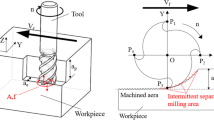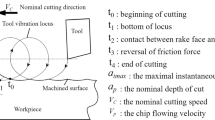Abstract
Titanium alloy is a typical difficult-to-cut material due to its high strength and high stiffness. To solve the problem of the low efficiency and poor surface quality in the milling of titanium alloy, this paper proposes a novel longitudinal-torsional ultrasonic vibration milling (LTUVM) process. An ultrasonic horn with spiral slots was designed to convert the longitudinal vibration into longitudinal-torsional vibration. The tooltip trajectory was modeled, and the finite elements analysis was used to analyze the cutting mechanism of LTUVM. The simulation results indicate a kind of separation cutting characteristics in every vibration cycle, which is beneficial to reduce the cutting force and improve the surface finish compared with the single longitudinal ultrasonic vibration milling (SLUVM). Then, cutting tests were conducted on Ti-6Al-4V to evaluate the performance of LTUVM. Experimental results demonstrated that the LTUVM could reduce the cutting force by 46–86% compared with the conventional milling (CM) and the SLUVM due to its separation cutting characteristics. Moreover, the surface morphology was analyzed, and a fractal dimension (FD) method was proposed to characterize the regularity and fragmental property of the machined surfaces. The surface morphology analysis results showed that the LTUVM can be used as a novel high-efficiency and high-quality surface texturing method for Ti-6Al-4V. The textured surface of the LTUVM has the superiority of high integrity and periodicity, which could be applied to effectively tune the tribological property of surface.

















Similar content being viewed by others
Data availability
All the data have been presented in the manuscript.
References
Ellyson B, Brochu M, Brochu M (2017) Characterization of bending vibration fatigue of SLM fabricated Ti-6Al-4V. Int J Fatigue 99:25–34. https://doi.org/10.1016/j.ijfatigue.2017.02.005
Mohsan AUIH, Liu Z, Padhy GK (2017) A review on the progress towards improvement in surface integrity of Inconel 718 under high pressure and flood cooling conditions. Int J Adv Manuf Technol 91(1):107–125. https://doi.org/10.1007/s00170-016-9737-3
Umbrello D (2008) Finite element simulation of conventional and high speed machining of Ti6Al4V alloy. J Mater Process Technol 196(1):79–87. https://doi.org/10.1016/j.jmatprotec.2007.05.007
Shokrani A, Dhokia V, Newman ST (2016) Investigation of the effects of cryogenic machining on surface integrity in CNC end milling of Ti–6Al–4V titanium alloy. J Manuf Process 21:172–179. https://doi.org/10.1016/j.jmapro.2015.12.002
Zhang C, Zhang J, Feng P (2013) Mathematical model for cutting force in rotary ultrasonic face milling of brittle materials. Int J Adv Manuf Technol 69(1):161–170. https://doi.org/10.1007/s00170-013-5004-z
Maurotto A, Muhammad R, Roy A, Silberschmidt VV (2013) Enhanced ultrasonically assisted turning of a β-titanium alloy. Ultrasonics 53(7):1242–1250. https://doi.org/10.1016/j.ultras.2013.03.006
Patil S, Joshi S, Tewari A, Joshi SS (2014) Modelling and simulation of effect of ultrasonic vibrations on machining of Ti6Al4V. Ultrasonics 54(2):694–705. https://doi.org/10.1016/j.ultras.2013.09.010
Chenjun W, Chen S, Cheng K, Xiao C (2019) Investigation of strengthening effect on the machining rigidity in longitudinal torsional ultrasonic milling of thin-plate structures. Proc Inst Mech Eng B J Eng Manuf 234:095440541987534. https://doi.org/10.1177/0954405419875346
Ying N, Feng J, Bo Z, Guofu G, Jing-jing N (2020) Theoretical investigation of machining-induced residual stresses in longitudinal torsional ultrasonic–assisted milling. Int J Adv Manuf Technol 108(11):3689–3705. https://doi.org/10.1007/s00170-020-05495-4
Wang J, Zhang J, Feng P, Guo P, Zhang Q (2017) Feasibility study of longitudinal-torsional-coupled rotary ultrasonic machining of brittle material. J Manuf Sci Eng 140. https://doi.org/10.1115/1.4038728
Amini S, Soleimani M, Paktinat H, Lotfi M (2016) Effect of longitudinal-torsional vibration in ultrasonic assisted drilling. Mater Manuf Process 32:616–622. https://doi.org/10.1080/10426914.2016.1198027
Tong J, Zhao J, Chen P, Zhang Z, Zhao B (2019) Effect of ultrasonic longitudinal–torsional composite milling of the residual stress on the surface of titanium alloy. Proc Inst Mech Eng C J Mech Eng Sci 234:095440621989659. https://doi.org/10.1177/0954406219896595
Rinck PM, Gueray A, Kleinwort R, Zaeh MF (2020) Experimental investigations on longitudinal-torsional vibration-assisted milling of Ti-6Al-4V. Int J Adv Manuf Technol 108(11):3607–3618. https://doi.org/10.1007/s00170-020-05392-w
Gao G, Xia Z, Yuan Z, Xiang D, Zhao B (2020) Influence of longitudinal-torsional ultrasonic-assisted vibration on micro-hole drilling Ti-6Al-4V. Chin J Aeronaut. https://doi.org/10.1016/j.cja.2020.06.012
Tsujino J, Ueoka T, Otoda K, Fujimi A (2000) One-dimensional longitudinal–torsional vibration converter with multiple diagonally slitted parts. Ultrasonics 38(1):72–76. https://doi.org/10.1016/S0041-624X(99)00175-4
Harkness P, Cardoni A, Lucas M (2009) Ultrasonic rock drilling devices using longitudinal-torsional compound vibration. https://doi.org/10.1109/ULTSYM.2009.5441855
Rose JL (2014) Ultrasonic guided waves in solid media. Ultrasonic guided waves in solid media:1–512. doi:https://doi.org/10.1017/CBO9781107273610
Zhang Q, Zhang J, Feng P (2019) Characteristics of longitudinal-torsional vibration of ultrasonic horn with slanting slots. J Vib Shock 38(10):63–69+83. https://doi.org/10.13465/j.cnki.jvs.2019.10.009
Cai W, Zhang J, Feng P, Yu D, Wu Z (2017) A bilateral capacitance compensation method for giant magnetostriction ultrasonic processing system. Int J Adv Manuf Technol 90(9):2925–2933. https://doi.org/10.1007/s00170-016-9602-4
Johnson GR, Cook WH (1983) A constitutive model and data for metals subjected to large strains, high strain rates and high temperatures. In: The 7th International Symposium on Ballistic, Hague, pp 541–547
Xu J, Deng Y, Wang C, Liang G (2021) Numerical model of unidirectional CFRP in machining: development of an amended friction model. Compos Struct 256:113075. https://doi.org/10.1016/j.compstruct.2020.113075
Ying N, Feng J, Bo Z (2020) A novel 3D finite element simulation method for longitudinal-torsional ultrasonic-assisted milling. Int J Adv Manuf Technol 106. https://doi.org/10.1007/s00170-019-04636-8
Xi Y, Bermingham M, Wang G, Dargusch M (2013) FEA modelling of cutting force and chip formation in thermally assisted machining of Ti6Al4V alloy. In: Materials Science Forum, Trans Tech Publications, pp 343–347. https://doi.org/10.4028/www.scientific.net/MSF.765.343
Kay (2020) Failure Modeling of Titanium6Al4V and 2024-T3 aluminum with the Johnson-Cook material model. https://doi.org/10.2172/15006359
Özel T, Zeren E (2007) Finite element modeling the influence of edge roundness on the stress and temperature fields induced by high-speed machining. Int J Adv Manuf Technol 35(3):255–267. https://doi.org/10.1007/s00170-006-0720-2
Feng F, Liu B, Zhang X, Qian X, Li X, Huang J, Qu T, Feng P (2018) Roughness scaling extraction method for fractal dimension evaluation based on a single morphological image. Appl Surf Sci 458:489–494. https://doi.org/10.1016/j.apsusc.2018.07.062
Zhang X, Xu Y, Jackson RL (2017) An analysis of generated fractal and measured rough surfaces in regards to their multi-scale structure and fractal dimension. Tribol Int 105:94–101. https://doi.org/10.1016/j.triboint.2016.09.036
Kovalchenko A, Ajayi O, Erdemir A, Fenske G, Etsion I (2004) The effect of laser texturing of steel surfaces and speed-load parameters on the transition of lubrication regime from boundary to hydrodynamic. Tribol Trans 47:299–307. https://doi.org/10.1080/05698190490440902
Galda L, Sep J, Olszewski A, Żochowski T (2019) Experimental investigation into surface texture effect on journal bearings performance. Tribol Int 136. https://doi.org/10.1016/j.triboint.2019.03.073
Chen P, Tong J, Zhao J, Zhang Z, Zhao B (2020) A study ofthe surface microstructure and tool wear of titanium alloys after ultrasonic longitudinal-torsional milling. J Manuf Process 53:1–11. https://doi.org/10.1016/j.jmapro.2020.01.040
Li Y, Xiang D, Feng H, Gao G, Shi Z (2020) Surface characteristics investigation of ultrasonic longitudinal-torsional milling of high–volume fraction SiCp/Al. Int J Adv Manuf Technol 110(7):2119–2130. https://doi.org/10.1007/s00170-020-05971-x
Funding
This work was supported by National Natural Science Foundation of China [Grant No. 51705281; Grant No. 51875311] and Shenzhen Foundational Research Project (Discipline Layout) [Grant No. JCYJ20180508152128308]. The third author (Jianjian Wang) would like to acknowledge the fellowship support from Alexander von Humboldt Foundation.
Author information
Authors and Affiliations
Contributions
Conceptualization, Y.P. and P.F.; methodology, J.W.; validation, Y.P., J.X. and J.W.; investigation, Y.P. and H.Z.; resources, J.X.; supervision, H.Z.; project administration, P.F. All authors have read and agreed to the published version of the manuscript.
Corresponding authors
Ethics declarations
Competing interests
The authors declare that they have no conflict of interests.
Ethical approval
Not applicable.
Consent to participate
The authors declare that they all consent to participate this research.
Consent to publish
The authors declare that they all consent to publish the manuscript.
Additional information
Publisher’s note
Springer Nature remains neutral with regard to jurisdictional claims in published maps and institutional affiliations.
Rights and permissions
About this article
Cite this article
Pang, Y., Feng, P., Wang, J. et al. Performance analysis of the longitudinal-torsional ultrasonic milling of Ti-6Al-4V. Int J Adv Manuf Technol 113, 1255–1266 (2021). https://doi.org/10.1007/s00170-021-06682-7
Received:
Accepted:
Published:
Issue Date:
DOI: https://doi.org/10.1007/s00170-021-06682-7




